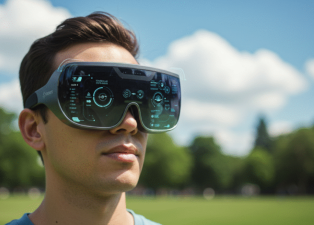If smart watches are cyber prostheses that regulate the body and mind, heart rate, blood oxygen, and lung capacity, it uses various indicators to prompt the limits of your physical functions, then the services provided by AR glasses, which will explode this year, are obviously much gentler and friendlier. The mission of AR glasses is to enhance your sense of control over the real world.
If smart watches are cyber prostheses that regulate the body and mind, heart rate, blood oxygen, and lung capacity, it uses various indicators to prompt the limits of your physical functions, then the services provided by AR glasses, which will explode this year, are obviously much gentler and friendlier.
The mission of AR glasses is to enhance your sense of control over the real world.
Augmented reality (AR) technology is reshaping the way all walks of life operate, and AR glasses, as the core carrier of this technology, are gradually becoming an important tool for the digital transformation of enterprises. Whether it is industrial manufacturing, medical health or education and training, AR glasses are bringing new solutions to enterprises. So, what are AR glasses for?

The core functions of AR glasses
- Real-time data visualization
AR glasses can project key information (such as equipment operation data, operation instructions, inventory information, etc.) into the user's field of view in real time, helping users quickly obtain the required information and improve work efficiency.
- Remote collaboration and guidance
Through AR glasses, users can share the first-person perspective image with remote experts or team members in real time to achieve efficient remote collaboration. This interactive method breaks geographical restrictions and shortens communication costs.
- Intelligent identification and early warning
With the help of AI algorithms and computer vision technology, AR glasses can automatically identify equipment anomalies, component defects or assembly errors, and issue early warnings in real time to improve production quality and safety.
- Immersive training and learning
AR glasses provide users with immersive training and learning experiences through the superposition of virtual content. Whether it is operational skills training or complex knowledge learning, it can be presented in an intuitive way to improve learning effects.
- Multi-system integration and collaboration
AR glasses can seamlessly connect with industrial software such as MES (manufacturing execution system) and ERP (enterprise resource planning) to achieve integrated collaboration in production planning, inventory management, equipment maintenance and other links, and optimize resource allocation.
Application scenarios of AR glasses
- Industrial manufacturing
In the field of industrial manufacturing, AR glasses can be used for equipment inspection, remote collaboration and employee training. By displaying equipment operation data and operation instructions in real time, technicians can quickly solve problems and improve production efficiency.
- Healthcare
In the medical industry, AR glasses provide doctors with a new diagnostic and treatment tool. By displaying patients' 3D image data and operation instructions in real time, doctors can complete operations more accurately and collaborate efficiently with team members.
- Education and training
In the field of education, AR glasses provide students with an immersive learning experience. Through the superposition of virtual content, students can intuitively understand complex knowledge and interact with virtual objects to enhance their learning interest and effectiveness.
- Logistics and warehousing
In the logistics and warehousing industry, AR glasses help staff quickly locate goods and optimize the sorting process. By displaying inventory information and navigation paths in real time, staff can greatly improve their work efficiency.
- Retail and display
In the retail industry, AR glasses can provide customers with innovative experiences such as virtual try-on and product display to improve shopping satisfaction. At the same time, it can also be used for corporate display activities to attract more attention through virtual content.
The actual value of AR glasses
- Improve production efficiency
Through real-time data visualization and remote collaboration functions, AR glasses can help companies quickly solve problems, reduce downtime, and improve production efficiency.
- Reduce training costs
AR glasses help employees quickly master operating skills through immersive training methods, reducing training costs and time.
- Optimize resource allocation
Through seamless integration with industrial software, AR glasses can achieve integrated collaboration in production planning, inventory management, equipment maintenance and other links, and optimize resource allocation.
- Enhance safety
Through intelligent recognition and early warning functions, AR glasses can detect equipment anomalies or operating errors in a timely manner and improve production safety.
- Improve customer experience
In the retail and service industries, AR glasses improve customer satisfaction and brand image through innovative experiences such as virtual try-on and product display.

